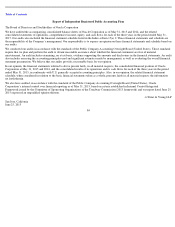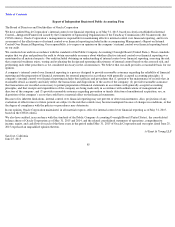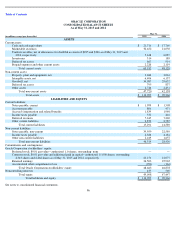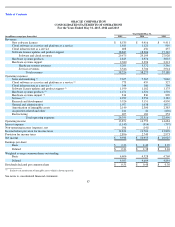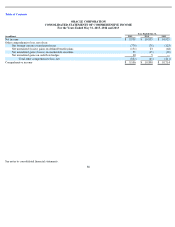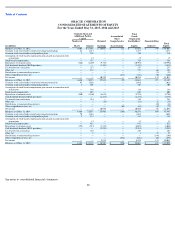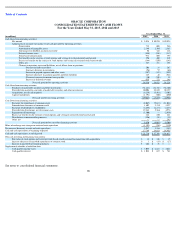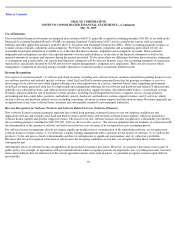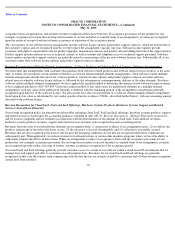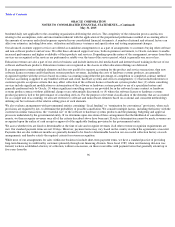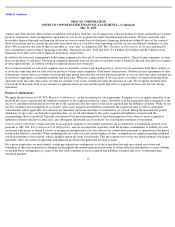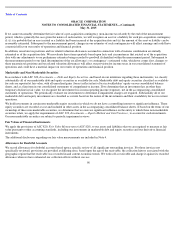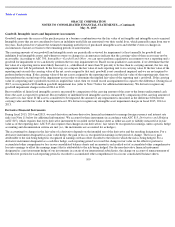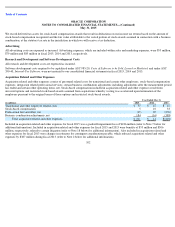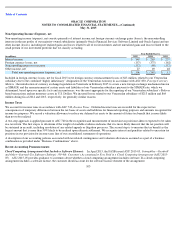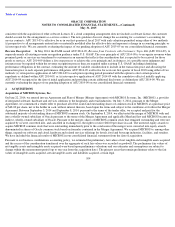Oracle 2014 Annual Report Download - page 98
Download and view the complete annual report
Please find page 98 of the 2014 Oracle annual report below. You can navigate through the pages in the report by either clicking on the pages listed below, or by using the keyword search tool below to find specific information within the annual report.
Table of Contents
ORACLE CORPORATION
NOTES TO CONSOLIDATED FINANCIAL STATEMENTS—(Continued)
May 31, 2015
Our cloud IaaS offerings provide deployment and management offerings for our software and hardware and related IT infrastructure including
comprehensive software and hardware management and maintenance services arrangements for customer IT infrastructure for a stated term that
is hosted at our data center facilities, select partner data centers or physically on-premises at customer facilities generally for a term-based fee;
and virtual machine instances that are subscription-based and designed for computing and reliable and secure object storage. Revenues for these
cloud IaaS offerings are generally recognized ratably over the contract term commencing with the date the service is made available to customers
and all other revenue recognition criteria have been satisfied.
Revenues from the sale of hardware systems products represent amounts earned primarily from the sale of our Oracle Engineered Systems,
computer servers, storage, networking and industry specific hardware.
Our hardware systems support offerings generally provide customers with software updates for the software components that are essential to the
functionality of our hardware products and can also include product repairs, maintenance services and technical support services. Hardware
systems support contracts are generally priced as a percentage of the net hardware systems products fees. Hardware systems support contracts
are entered into at the customer’s option and are recognized ratably over the contractual term of the arrangements, which are typically one year.
Revenue Recognition for Multiple-Element Arrangements—Cloud SaaS, PaaS and IaaS Offerings, Hardware Systems Products, Hardware
Systems Support and Related Services (Nonsoftware Arrangements)
We enter into arrangements with customers that purchase both nonsoftware related products and services from us at the same time, or within
close proximity of one another (referred to as nonsoftware multiple-element arrangements). Each element within a nonsoftware multiple-
element
arrangement is accounted for as a separate unit of accounting provided the following criteria are met: the delivered products or services have
value to the customer on a standalone basis; and for an arrangement that includes a general right of return relative to the delivered products or
services, delivery or performance of the undelivered product or service is considered probable and is substantially controlled by us. We consider
a deliverable to have standalone value if the product or service is sold separately by us or another vendor or could be resold by the customer.
Further, our revenue arrangements generally do not include a general right of return relative to the delivered products. Where the aforementioned
criteria for a separate unit of accounting are not met, the deliverable is combined with the undelivered element(s) and treated as a single unit of
accounting for the purposes of allocation of the arrangement consideration and revenue recognition. For those units of accounting that include
more than one deliverable but are treated as a single unit of accounting, we generally recognize revenues over the contractual period of the
arrangement or in the case of our cloud offerings, we generally recognize revenues over the contractual term of the cloud software subscription.
For the purposes of revenue classification of the elements that are accounted for as a single unit of accounting, we allocate revenue to the
respective revenue line items within our consolidated statements of operations based on a rational and consistent methodology utilizing our best
estimate of relative selling prices of such elements.
For our nonsoftware multiple-element arrangements, we allocate revenue to each element based on a selling price hierarchy at the arrangement’s
inception. The selling price for each element is based upon the following selling price hierarchy: VSOE if available, third party evidence (TPE)
if VSOE is not available, or estimated selling price (ESP) if neither VSOE nor TPE are available (a description as to how we determine VSOE,
TPE and ESP is provided below). If a tangible hardware systems product includes software, we determine whether the tangible hardware
systems product and the software work together to deliver the product’s essential functionality and, if so, the entire product is treated as a
nonsoftware deliverable. The total arrangement consideration is allocated to each separate unit of accounting for each of the nonsoftware
deliverables using the relative selling prices of each unit based on the aforementioned selling price hierarchy. We limit the amount of revenue
recognized for delivered elements to an amount that is not contingent upon future delivery of additional products or services or meeting of any
specified performance conditions.
94


